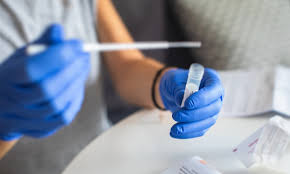As Omicron cases continue to fall from their historic highs across Colorado, it is becoming easier to begin to imagine life after COVID. Even Chaffee County Public Health Director Andrea Carlstrom has said that the hope is that by the end of February, through the combination of vaccinations and the massive spread of COVID-19 variant Omicron that it is expected that Colorado will hit the stage of herd immunity by the end of February, barring any other variant.

COVID Testing. Image courtesy of Johns Hopkins Bloomberg School of Public Health
“My call to action is to help us get these messages of hope and normalization out,” said Carlstrom during the latest COVID Leadership Roundtable. “The 18-35 ages are particularly stressed,” understandable since this is the age group most likely to have small children who still aren’t eligible for vaccines, and are balancing workplaces and a countywide shortage of daycare. “We need to be the voice of this shift moving forward, even as we protect our health care system from surging while shifting toward an endemic response to this, rather than the pandemic mode we’ve been in for nearly two years. Omicron at this moment should be our best friend.
That being said, it may be easy to forget that in Chaffee County, an area of around 20,000 residents, January 2022 had the highest recorded infections of the entire pandemic; 865 known cases. Which is double our worst month of Delta, and probably represents only a fraction of the true cases. But our local hospital recorded its lowest number of hospitalizations since August 2021.
The state’s seven-day positivity rate is still high; 10.86 percent (anything more than five percent is a spreading situation), but it’s much lower than it was. Municipalities and school districts, even the more cautious ones, are indicating they will drop face mask recommendations by the end of February (Chaffee Board of County Commissioners will be considering their county building mandates on March 1.)
Last week the state hit 80 percent of those eligible for vaccinations who have had at least one shot, and in Chaffee County, it is above 83 percent. In fact, some 74.5 percent of county residents are up-to-date on the doses they are supposed to have. Across the nation, about 60 percent of people have been boosted.
But here’s the thing — this virus will continue as a case of — the haves (meaning vaccinated) and the have nots (those who haven’t been vaccinated.
“The data is staggering regarding the vaccinated and boosted,” says Carlstrom.
View her full Guest Article this week for all the stats, but here’s a big scientific piece of data to remember: vaccinated people are 8.1 times less likely to die from COVID, and those who have received their COVID booster shot are 58.8 times less likely to die from COVID than unvaccinated people.
“According to the CDC (Centers for Disease Control) unvaccinated people are 97 percent more likely to die from COVID compared to vaccinated people,” said Carlstrom. “That stops you for a minute.”
Coming soon – vaccination dosages for those ages six months to five years. Based on this long-awaited news (especially for parents with young children) Carlstrom says that the CCPH will be folding kids’ appointments into their existing clinics. After that — what is your excuse?
“There is hope on the horizon my friends,” said Carlstrom. “We still need to buckle down and do the things making, the most difference in our community, through infection or vaccines, we could see herd immunity by the end of the month, or March … When things are looking good, we have to celebrate that, it’s respite.”
In the next months she predicts we will see:
- More access to testing
- The ongoing need to vaccinate the unvaccinated
- Local outbreaks of infections
- The long-term waning of the vaccine efficacy






Recent Comments